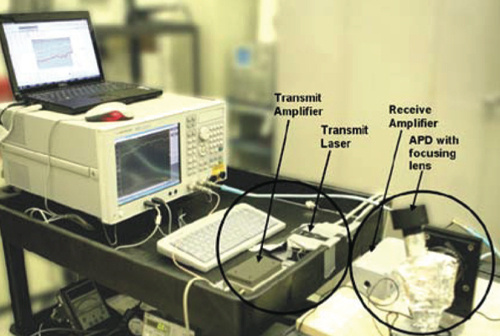Wireless speed achived 1Gbps streaming rate!
It’s a great achievement. The uses of higher higher bandwidth mobile access has been increasing because of the multimedia services, video calling, video conferencing, video on demand etc. Wireless network transmits data in the form of radio wave. But a Penn State graduate student and professor have built a system that transmits wireless data at 1 Gbps over infrared light. They built a wireless network that used reflected infrared light instead of radio waves, had transmitted data through the air at a speed of one gigabit per second–six to 14 times faster than the fastest Wi-Fi network. Last month, Siemens get to 500Mbps streaming using white LEDs, but this infrared solution works at twice that speed.

Penn State graduate student Jarir Fadlullah and Mohsen Kavehrad, professor of electrical engineering and director of the university’s Center for Information and Communications Technology Research, built and tested the experimental system. Their setup sent data across a room by modulating a beam of infrared light that was focused on the ceiling and picking up the reflections using a specially modified photodetector. The pair says that their measurements show the system could support data rates “well beyond” the one gigabit per second they are currently claiming.
“This probably will be the next generation wireless communications technology,” says Zhengyuan Daniel Xu, professor of electrical engineering at the University of California, Riverside. Xu is also the director of the UC-Light Center, a consortium of researchers working on wireless optical communications at different UC campuses. “Light will give you higher data rates than radio frequencies, and RF already has a very congested spectrum.”
Optical wireless networks could also offer less interference and greater security than radio-frequency networks, Kavehrad says. While radio signals pass through walls and doors, light does not, making it easier to reuse frequencies and more difficult to intercept transmissions. He also notes that unlike radio frequencies, the spectral region for all light–infrared, visible, and ultraviolet–is unregulated worldwide. This could make it easier to commercialize optical wireless networks.
Researchers have studied indoor optical communications since the late 1970s, when engineers at IBM Zürich built the first working system. The technology languished because the Internet was still in its infancy, and there was no demand for wireless broadband systems–though interest has picked up in the past few years.
While there are some hurdles to overcome before optical wireless networks become commonplace, the professor who guided the project believes that if the technology continues to develop at its current pace, we could see a practical application within three years.
Sources: PSU, Technology Review, Gizmodo
Popularity: 1% [?]
Amazon.com: Deal Of The Day
Tags: Bandwidth, Data Rate, infrared light, LED, Light, Mobile Access, multimedia services, optical wireless networks, Optocal newtwork, Penn State, radio frequency, Radio Wave, RF, Siemens, Streaming, video calling, video conferencing, video on demand, Wi-Fi, Wireless, wireless communications technology





